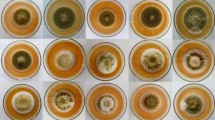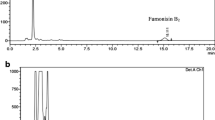Abstract
Many agricultural products are susceptible to contamination by aflatoxin-producing species from Aspergillus section Flavi. The objectives of this study were to determine the occurrence of Aspergillus section Flavi in four agricultural products, such as pistachio, walnut, hazelnut, and dried fruits, collected from market and retail shops in various areas of Kerman County and obtain information on the relationships between isolation source and ability to produce sclerotia and potential for aflatoxin production. Aspergillus species were identified based on morphological characteristics as well as subsequent sequencing of the parts of the β-tubulin and calmodulin genes. From 207 isolated strains, the following species were identified: A. flavus, A. tamarii A. nomius, A. parasiticus, A. arachidicola, A. caelatus, A. pseudotamarii, and A. leporis. To the best of our knowledge, this is the first report of A. pseudotamarii and A. arachidicola with the potential to produce aflatoxins from dried apricots and hazelnuts, respectively. Sclerotial type was significantly different between isolates from different isolation sources. From 192 tested isolates, 38% were aflatoxin producer from which 5% were scored as strong aflatoxin producers and 33% as average aflatoxin producers. A significant difference in the population of aflatoxin-producing strains across the isolation sources was observed which may reflect host adaptation and thereby different vulnerabilities to aflatoxin-producing species among the examined products.





Similar content being viewed by others
Data Availability
The datasets generated during and/or analyzed during the current study are available from the corresponding author on reasonable request.
Code availability
Not applicable.
References
Perrone G, Susca A, Cozzi G, Ehrlich K, Varga J, Frisvad JC, Meijer M, Noonim P, Mahakarnchanakul W, Samson RA (2007) Biodiversity of Aspergillus species in some important agricultural products. Stud Mycol 59:53–66. https://doi.org/10.3114/sim.2007.59.07
Houbraken J, Kocsubé S, Visagie C, Yilmaz N, Wang X-C, Meijer M, Kraak B, Hubka V, Bensch K, Samson RF, JC. (2020) Classification of Aspergillus, Penicillium, Talaromyces and related genera (Eurotiales): an overview of families, genera, subgenera, sections, series and species. Stud Mycol 95:5–169. https://doi.org/10.1016/j.simyco.2020.05.002
Okoth S, De Boevre M, Vidal A, Diana Di Mavungu JL, Schoot S, Kyallo M, Njuguna J, Harvey J, De Saeger S (2018) Genetic and toxigenic variability within Aspergillus flavus population isolated from maize in two diverse environments in Kenya. Front Microbiol 9:57. https://doi.org/10.3389/fmicb.2018.00057
Agbetiameh D, Ortega-Beltran A, Awuah RT, Atehnkeng J, Elzein A, Cotty PJ, Bandyopadhyay R (2020) Field efficacy of two atoxigenic biocontrol products for mitigation of aflatoxin contamination in maize and groundnut in Ghana. Biol Control 150:104351. https://doi.org/10.1016/j.biocontrol.2020.104351
Aikore MOS, Ortega-Beltran A, Eruvbetine D, Atehnkeng J, Falade TDO, Cotty PJ, Bandyopadhyay R (2019) Performance of broilers fed with maize colonized by either toxigenic or atoxigenic strains of Aspergillus flavus with and without an aflatoxin-sequestering agent. Toxins 11(10):565. https://doi.org/10.3390/toxins11100565
Bandyopadhyay R, Atehnkeng J, Ortega-Beltran A, Akande A, Falade TDO, Cotty PJ (2019) “Ground-Truthing” efficacy of biological control for aflatoxin mitigation in farmers’ fields in Nigeria: from field trials to commercial usage, a 10-year study. Front Microbiol 10:2528. https://doi.org/10.3389/fmicb.2019.02528
Abbas HK, Weaver MA, Zablotowicz RM, Horn BW, Shier WT (2005) Relationships between aflatoxin production and sclerotia formation among isolates of Aspergillus section Flavi from the Mississippi Delta. Eur J Plant Pathol 112:283–287. https://doi.org/10.1007/s10658-004-4888-8
Razzaghi-Abyaneh M, Shams-Ghahfarokhi M, Allameh A, Kazeroon-Shiri A, Ranjbar-Bahadori S, Mirzahoseini H, Rezaee MB (2006) A survey on distribution of Aspergillus section Flavi in corn field soils in Iran: population patterns based on aflatoxins, cyclopiazonic acid and sclerotia production. Mycopathologia 161(3):183–192. https://doi.org/10.1007/s11046-005-0242-8
Novas MV, Cabral D (2002) Association of mycotoxin and sclerotia production with compatibility groups in Aspergillus flavus from peanut in Argentina. Plant dis 86(3):215–219. https://doi.org/10.1094/PDIS.2002.86.3.215
Acur A, Arias RS, Odongo S, Tuhaise S, Ssekandi J, Muhanguzi D, Kiggundu A (2020) Genetic diversity of aflatoxin-producing Aspergillus flavus isolated from groundnuts in selected agro-ecological zones of Uganda. BMC Microbiol 20:252. https://doi.org/10.1186/s12866-020-01924-2
Horn BW, Dorner JW (1998) Soil populations of Aspergillus species from section Flavi along a transect through the peanut-growing regionsof the United States. Mycologia 90:767–776. https://doi.org/10.1080/00275514.1998.12026969
Amiri MJ, Karami M, Sadeghi E (2013) Determination of AFB1 in peanut, almond, walnut, and hazelnut in kermanshah markets, Iran. Int J Agri Crop Sci 6(17):1199–1202
Heshmati A, Zohrevand T, Khaneghah AM, Nejad ASM, Sant’Ana AS, (2017) Co-occurrence of aflatoxins and ochratoxin A in dried fruits in Iran: Dietary exposure risk assessment. Food Chem Toxicol 106:202–208. https://doi.org/10.1016/j.fct.2017.05.046
Ait Mimoune N, Arroyo-Manzanares N, Gámiz-Gracia L, García-Campaña AM, Bouti K, Sabaou N, Riba A (2018) Aspergillus section Flavi and aflatoxins in dried figs and nuts in Algeria. Food Addit Contam Part B Surveill 11:119–125. https://doi.org/10.1080/19393210.2018.1438524
Pitt JI, Hocking AD (2009) Fungi and food spoilage, 3rd edn. Springer, New York
King AD, Hocking AD, Pitt JI (1979) Dichloran-rose bengal medium for enumeration and isolation of molds from foods. Appl Environ Microbiol 37(5):959–964. https://doi.org/10.1128/aem.37.5.959-964.1979
Pitt JI, Hocking AD, Glenn DR (1983) An improved medium for the detection of Aspergillus flavus and Aspergillus parasiticus. J Appl Bacteriol 54:109–114. https://doi.org/10.1111/j.1365-2672.1983.tb01307.x
Pitt JI (1979) The genus Penicillium and its teleomorphic states Eupenicillium and Talaromyces. Academic Press Inc, London
Klich MA (2002) Identification of common Aspergillus species. Centraalbureau voor Schimmelcultures, Utrecht
Samson RA, Visagie CM, Houbraken J, Hong SB, Hubka V, Klaassen CHW, Perrone G, Seifert KA, Susca A, Tanney JB, Varga J, Szigeti KS, G, Yaguch T, Frisvad JC, (2014) Phylogeny, identification and nomenclature of the genus Aspergillus. Stud Mycol 78:141–173. https://doi.org/10.1016/j.simyco.2014.07.004
Hong SB, Cho HS, Shin HD, Frisvad JC, Samson RA (2006) Novel Neosartorya species isolated from soil in Korea. Int J Syst Evol 56:477–486. https://doi.org/10.1099/ijs.0.63980-0
Glass NL, Donaldson GC (1995) Development of primer sets designed for use with the PCR to amplify conserved genes from filamentous ascomycetes. Appl Environ Microbiol 61:1323–1330. https://doi.org/10.1128/AEM.61.4.1323-1330.1995
Ronquist F, Teslenko M, Van Der Mark P, Ayres DL, Darling A, Höhna S, Larget B, Liu L, Suchard MA, Huelsenbeck JP (2012) MrBayes 3.2: efficient Bayesian phylogenetic inference and model choice across a large model space. Syst Biol 61:539–542. https://doi.org/10.1093/sysbio/sys029
Posada D (2008) jModelTest: phylogenetic model averaging. Mol Biol Evol 25:1253–1256. https://doi.org/10.1093/molbev/msn083
Swofford DL (2002) PAUP*: phylogenetic analysis using parsimony (*and other methods). Sinauer Associates, Sunderland
Saito M, Machida S (1999) A rapid identification method for aflatoxin-producing strains of Aspergillus flavus and A. parasiticus by ammonia vapor. Mycoscience 40:205–208. https://doi.org/10.1007/BF02464300
Abbas HK, Zablotowicz RM, Weaver MA, Horn BW, Xie W, Shier WT (2004) Comparison of cultural and analytical methods for determination of aflatoxin production by Mississippi Delta Aspergillus isolates. Can J Microbiol 50:193–199. https://doi.org/10.1139/w04-006
Davis ND, Diener UL, Eldridge DW (1966) Production of Aflatoxins B1 and G1 by Aspergillus flavus in a semisynthetic medium. Appl Environ Microbiol 14:378–380. https://doi.org/10.1128/AEM.14.3.378-380.1966
Fani SR, Moradi M, Probst C, Zamanizadeh HR, Mirabolfathy M, Haidukowski M, Logrieco AF (2014) A critical evaluation of cultural methods for the identification of atoxigenic Aspergillus flavus isolates for aflatoxin mitigation in pistachio orchards of Iran. Eur J Plant Pathol 140:631–642. https://doi.org/10.1007/s10658-014-0499-1
Houshyarfard M, Rouhani H, Falahati-Rastegar M, Malekzadeh-Shafaroudi S, Mehdikhani-Moghaddam E, Probst C (2014) Characterization of Aspergillus section Flavi from pistachio soils in Iran. J Plant Prot Res. https://doi.org/10.2478/jppr-2014-0053
Ostadrahimi A, Ashrafnejad F, Kazemi A, Sargheini N, Mahdavi R, Farshchian M et al (2014) Aflatoxin in raw and salt-roasted nuts (pistachios, peanuts and walnuts) sold in markets of Tabriz. Iran Jundishapur J Microbiol 7(1):8674. https://doi.org/10.5812/jjm.8674
Wicklow DT, Mcalpin CE, Platis CE (1998) Characterization of the Aspergillus flavus population within an Illinois maize field. Mycol Res 102:263–268. https://doi.org/10.1017/S0953756297004851
Giorni P, Magan N, Pietri A, Bertuzzi T, Battilani P (2007) Studies on Aspergillus section Flavi isolated from maize in northern Italy. Int J food Microbiol 113:330–338. https://doi.org/10.1016/j.ijfoodmicro.2006.09.007
Mamo FT, Shang B, Selvaraj JN, Wang Y, Liu Y (2018) Isolation and characterization of Aspergillus flavus strains in China. J Microbiol 56(2):119–127. https://doi.org/10.1007/s12275-018-7144-1
Perrone G, Haidukowski M, Stea G, Epifani F, Bandyopadhyay R, Leslie JF, Logrieco A (2014) Population structure and Aflatoxin production by Aspergillus Sect. Flavi from maize. Food Microbiol 41:52–59. https://doi.org/10.1016/j.fm.2013.12.005
Okun DO, Khamis FM, Muluvi GM, Ngeranwa JJ, Ombura FO, Yongo MO, Kenya EU (2015) Distribution of indigenous strains of atoxigenic and toxigenic Aspergillus flavus and Aspergillus parasiticus in maize and peanuts agro-ecological zones of Kenya. Agric Food Secur 4(1):14. https://doi.org/10.1186/s40066-015-0033-5
Matabaro E, Ishimwe N, Uwimbabazi E, Lee BH (2017) Current immunoassay methods for the rapid detection of aflatoxin in milk and dairy products. Compr Rev Food Sci Food Saf 16(5):808–820. https://doi.org/10.1111/1541-4337.12287
Shier WT, Lao Y, Steele TW, Abbas HK (2005) Yellow pigments used in rapid identification of aflatoxin-producing Aspergillus strain are anthraquinones associated with the aflatoxin biosynthetic pathway. Bioorg Chem 33:426–438. https://doi.org/10.1016/j.bioorg.2005.09.002
Jamali M, Ebrahimi MA, Karimipour M, Shams-Ghahfarokhi M, Dinparast-Djadid N, Kalantari S, Pilehvar-Soltanahmadi Y, Amani A, Razzaghi-Abyaneh M (2012) An insight into the distribution, genetic diversity, and mycotoxin production of Aspergillus section Flavi in soils of pistachio orchards. Folia Microbiol 57(1):27–36. https://doi.org/10.1007/s12223-011-0090-5
Amani S, Shams-Ghahfarokhi M, Banasaz M, Razzaghi-Abyaneh M (2012) Mycotoxin-producing ability and chemotype diversity of Aspergillus section Flavi from soils of peanut-growing regions in Iran. Indian J Microbiol 52:551–556. https://doi.org/10.1007/s12088-012-0275-x
Ortega-Beltran A, Moral J, Picot A, Puckett RD, Cotty PJ, Michailides TJ (2019) Atoxigenic Aspergillus flavus isolates endemic to almond, fig, and pistachio orchards in California with potential to reduce aflatoxin contamination in these crops. Plant Dis 103(5):905–912. https://doi.org/10.1094/PDIS-08-18-1333-RE
Goto T, Wicklow DT, Ito Y (1996) Aflatoxin and cyclopiazonic acid production by a sclerotium-producing Aspergillus tamarii strain. Appl Environ Microbiol 62(11):4036–4038
Klich M, Mullaney E, Daly C, Cary J (2000) Molecular and physiological aspects of aflatoxin and sterigmatocystin biosynthesis by Aspergillus tamarii and A. ochraceoroseus. Appl Microbiol Biotechnol 53(5):605–609. https://doi.org/10.1007/s002530051664
Kheiralla ZH, Hassanin NI, Amra H (1992) Effect of incubation time, temperature and substrate on growth and aflatoxin production. Int Biodeterior Biodegrad 30(1):17–27. https://doi.org/10.1016/0964-8305(92)90021-F
Magan N, Aldred D (2007) Why do fungi produce mycotoxins? In: Dijksterhuis J, RA, Samson, (eds) Food mycology: a multifaceted approach to fungi and food. CRC Press, Boca Raton, FL, pp 121–133
Liu J, Sun L, Zhang N, Zhang J, Guo J, Li C, Rajput SA, Qi D (2016) Effects of nutrients in substrates of different grains on aflatoxin B1 production by Aspergillus flavus. Biomed Res Int. https://doi.org/10.1155/2016/7232858
Chang PK, Bennett JW, Cotty PJ (2001) Association of aflatoxin biosynthesis and sclerotial development in Aspergillus parasiticus. Mycopathologia 153:41–48. https://doi.org/10.1023/a:1015211915310
Hua SST, McAlpin CE, Chang PK, Sarreal SBL (2012) Characterization of aflatoxigenic and non-aflatoxigenic Aspergillus flavus isolates from pistachio. Mycotoxin Res 28(1):67–75. https://doi.org/10.1007/s12550-011-0117-4
Astoreca A, Dalcero A, Pinto VF, Vaamonde G (2011) A survey on distribution and toxigenicity of Aspergillus section Flavi in poultry feeds. Int J food Microbiol 146(1):38–43. https://doi.org/10.1016/j.ijfoodmicro.2011.01.034
Rodrigues P, Venâncio A, Kozakiewicz Z, Lima N (2009) A polyphasic approach to the identification of aflatoxigenic and non-aflatoxigenic strains of Aspergillus section Flavi isolated from Portuguese almonds. Int J Food Microbiol 129(2):187–193. https://doi.org/10.1016/j.ijfoodmicro.2008.11.023
Okoth S, Nyongesa B, Joutsjoki V, Korhonen H, Ayugi V (2016) Sclerotia formation and toxin production in large sclerotial Aspergillus flavus isolates from Kenya. Adv Microbiol 06(01):47–56. https://doi.org/10.4236/aim.2016.61005
Norlia M, Jinap S, Nor-Khaizura M, Radu S, Samsudin NIP, Farah FA (2019) Aspergillus section Flavi and aflatoxins: occurrence, detection, and identification in raw peanuts and peanut-based products along the supply chain. Front Microbiol 10:2602. https://doi.org/10.3389/fmicb.2019.02602
Funding
This work was supported by the Iran National Science Foundation (INSF) under grant number 96000908 and the Institute of Science and High Technology and Environmental Sciences, Graduate University of Advanced Technology, Kerman, Iran, under Grant No. 97/532.
Author information
Authors and Affiliations
Contributions
The study concept and design were performed by AH and DA; The experiments, data analysis, and the manuscript drafting were performed by AH; the funds were collected by AH; all authors read and approved the final manuscript.
Corresponding author
Ethics declarations
Conflict of interest
The authors declare no conflicts of interest regarding the publication of this paper.
Consent to Participate
The authors have agreed to be listed and approved the submitted version of the manuscript.
Additional information
Publisher's Note
Springer Nature remains neutral with regard to jurisdictional claims in published maps and institutional affiliations.
Rights and permissions
About this article
Cite this article
Habibi, A., Afzali, D. Aspergillus Section Flavi from Four Agricultural Products and Association of Mycotoxin and Sclerotia Production with Isolation Source. Curr Microbiol 78, 3674–3685 (2021). https://doi.org/10.1007/s00284-021-02620-8
Received:
Accepted:
Published:
Issue Date:
DOI: https://doi.org/10.1007/s00284-021-02620-8




